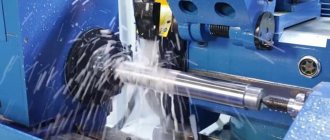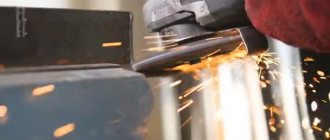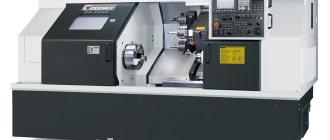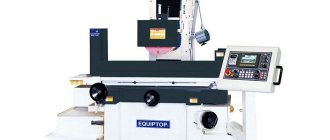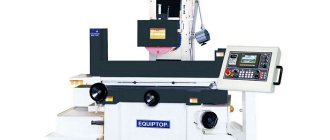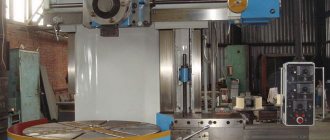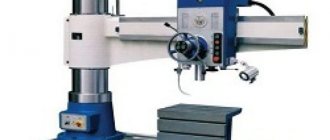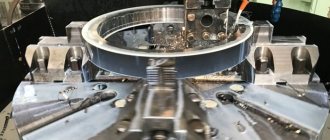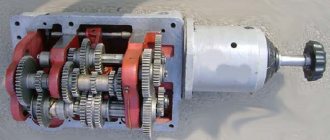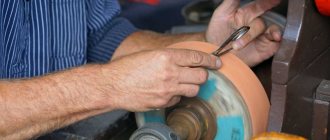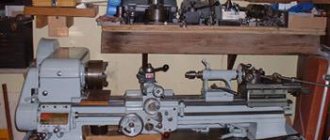Various tools and equipment are used to process metal surfaces. Cylindrical grinding machines can be used to work with round parts. They are large in size, but have many advantages - ease of operation, high accuracy, several operating modes. But how does a cylindrical grinding machine work from an engineering point of view? What features do these devices have? And how to choose a machine for a production workshop or factory? These issues will be discussed in the article.
Basic information
A cylindrical grinding machine is a device for automatically grinding metal products. The installation looks like a large table on which additional grinding equipment is installed. The operating principle of cylindrical grinding machines is simple. Using headstocks or a carriage, the metal part to be processed is installed in the working area. After this, the grinding wheel is started and rotates around its axis. The circle approaches the workpiece, which leads to stripping of the metal workpiece.
Using a cylindrical grinding machine, you can process cylindrical, conical and end workpieces, as well as large holes. By design, there are centered and centerless models. For center models, the workpiece is secured using special grooves. In centerless models, the workpiece is fixed in the working area of the machine using a clamping carriage. A cylindrical grinding machine performs the following tasks: abrasive rubbing of the surface of the workpiece, removing an excess layer of metal, eliminating irregularities on the metal surface.
Elements of cylindrical grinding systems
- Desktop. Acts as a base on which all the main elements are attached. The workbench may have small wheels that are used to transport the unit. The work table is made of durable metal alloys, as are other elements of the grinding system.
- Headstock grooves (center models). Used for fastening parts on the desktop. The grooves can rotate around their axis, which allows you to process the workpiece over its entire area + improves the quality of grinding. Some grooves can also move in the longitudinal direction, which allows you to change the position of the part on the work table directly during processing. The head slots can be movable - this allows you to change the angle of the workpiece on the work table. This makes it possible to grind conical workpieces.
- Carriage (centerless models). The carriage is also used for fastening parts on the work table. The main difference from the headstock grooves is that the carriage does not have its own axis of rotation (it can only be moved in the horizontal direction). To process the workpiece from different sides, the workpiece itself is rotated on the carriage.
- Abrasive disc wheel. Located in a perpendicular direction relative to the location of the workpiece on the work table. During operation, it acts as an abrasive with which processing is performed. Abrasive discs come in different shapes. Simple machines have a fixed disk arrangement. The universal cylindrical grinding machine has a movable disc wheel, which makes the installation more versatile.
- Drive unit. Used to move the abrasive wheel while the system is operating. The drive can be mechanical, hydraulic and electric. Large systems are usually equipped with an electric drive, which simplifies the procedure for moving the disk during operation. Small machines have a mechanical or hydraulic drive, which reduces electricity consumption.
- Electric motor. Acts as an energy source that powers all the main elements of the installation (rotating slots-headstocks, abrasive disc-wheel, etc.). If the machine is equipped with an electric drive, then the engine also powers this element. Electric motors usually have a power ranging from 5 to 15 kilowatts, although more powerful units are also available. Modern electric motors usually have additional protective elements to avoid system overheating.
- Cooling system. During processing, serious heating of the workpiece occurs due to friction. To avoid overheating of the workpiece, many modern machines are equipped with a cooling system. It looks like small taps that are installed in the core. The taps are connected to the refrigerant (the refrigerant is usually water). During processing of the part, the valves are activated, which leads to the spraying of coolant in the core.
Application area
Cylindrical grinding machines are used for external processing of cylindrical and conical parts made of ferrous and non-ferrous metals using the method of longitudinal, plunge and depth grinding in conditions of single, serial and mass production in the field of metallurgy and mechanical engineering at production sites in the workshops of enterprises. Also, the mentioned equipment can often be found in laboratories and research departments of factories and factories. Compact cylindrical grinding machines are actively used in repair shops, vehicle service stations, and garages. In addition, the units are used in workshops of vocational educational institutions that train machine tool specialists.
Features of cylindrical grinding machines
The equipment design includes the following elements:
- bed;
- upper and lower tables;
- device for internal grinding;
- quill;
- fastenings for grinding wheels;
- headstock;
- electrical cabinet;
- mechanism for straightening the abrasive wheel;
- Remote Control.
We offer to buy a cylindrical grinding machine, which makes it possible to process any metal surface with high precision. It is noteworthy that the work tables of these units can be equipped with additional stiffening ribs to increase strength and make it possible to work with large parts that exhibit significant mass. Hydraulic workpiece feeding systems ensure cyclic processing of parts with minimal time.
In our company's catalog you can buy a cylindrical grinding machine with sliding guides, which are covered with special covers to prevent contamination. Tables move along them, driven by a manual mechanism or a hydraulic system. The presence of a folding indicator device on the front of the high-strength frame allows you to control table movements with high accuracy. Segmental self-aligning bearings on which the spindle of the grinding headstock is mounted provide rigidity of support and increased rotational accuracy.
, which supplies customers from Russia and neighboring countries with equipment for processing metal parts, gives customers the opportunity to buy a cylindrical grinding machine with an electric locking of the grinding head motor, which protects the equipment from overloads. It is also noteworthy that the inclined working surface of the unit helps to move the tailstock and headstock without losing alignment. Grinding wheels of various grain sizes and hardness are used as tools for abrasive processing of parts. To straighten them, special devices with carbide discs are used.
Advantages of cylindrical grinding machines
We advise visitors to buy a cylindrical grinding machine that demonstrates advantages such as:
- safety in use, subject to all rules for working with equipment;
- automatic lubrication system for spindle heads, reducing wear and increasing the service life of spindles;
- a system that makes it possible to regulate the speed of longitudinal transmission without jerking;
- accelerated approach and retraction of the grinding wheel to save time and increase productivity;
- high reliability in use due to the impeccable quality of components from which industrial cylindrical grinding machines are assembled;
- the presence of an effective cooling system that allows reducing the temperature of the grinding wheel during rotation and extending its service life;
- hydraulic or manual (mechanical) high-precision movement of work tables and spindle heads;
- stability of the shape of the working area during load fluctuations;
- devices that ensure quick removal of flanges and, if necessary, replacement;
- the presence of splash guards that prevent liquid contaminated with metal particles from entering the operator’s clothing;
- the possibility of installing magnetic separators or paper filters for the grinding wheel cooling system;
- reliable and durable electric motors that consume moderate electricity;
- stable processing quality;
- maintainability and the ability to replace components.
Features of cylindrical grinding machines
Control is carried out manually using mechanical and hydraulic drives. Also, many modern installations are equipped with a numerical control (CNC) panel, which allows automation of most production processes. This not only simplifies the worker’s task, but also has a beneficial effect on the quality of processing.
To be allowed to install (both with and without a CNC panel), the worker must undergo appropriate training. He must also undergo training regarding workplace safety rules. During operation, a person must be careful not to damage the part and harm his health. Depending on the design, the following types of installations are distinguished:
- Simple machine. In such installations, you can only change the angle of the table on which the main part is fixed, and the grinding disk has a fixed position. This makes it possible to process cone-shaped parts with a small apex angle. The fixed location of the disk impairs the versatility of the system, but significantly reduces its cost. Therefore, in the case of small industries (auto repair shops, home construction), purchasing a simple machine may be a justified decision.
- Universal cylindrical grinding machine. On such systems, both the table and the processing disk can be rotated. This allows you to grind all types of parts (flat, conical, end, variable diameter), as well as individual holes inside workpieces. A universal cylindrical grinding machine is usually equipped with a CNC, which can significantly increase the quality of processing. Such installations are more expensive than simple systems, and they are usually used in industry (mechanical engineering, repair of ships or aircraft, weapons production).
Characteristics
You can evaluate the capabilities of the machine according to the declared characteristics from the manufacturer. It is necessary to understand the main parameters that are noted in the technical passport:
- The power of a metal machine is indicated in kW. The performance of the machine depends on this indicator.
- The power supply of the device depends on the dimensions of the equipment, the number of working spindles, and the power of the engines. It can be powered from a general network of 220 volts (models for workshops) or from 380 volts (industrial models).
- Dimensions of the desktop. The permissible size of processed workpieces depends on them.
- Diameter of equipment (grinding wheel). Its dimensions are indicated according to GOST standards.
- The number of spindle revolutions per minute.
Additionally, the main characteristics include the dimensions of the machine itself.
Types of grinding
Grinding using a cylindrical grinding machine can be carried out by three main methods - plunging, shoulder processing, longitudinal working stroke. Each of the techniques has several additional modifications, so there are many more actual processing scenarios.
Basic processing techniques
- Longitudinal grinding. The workpiece is installed in special grooves, which perform rotational movements during operation. The grooves move at low speed along (the speed is adjusted manually or using CNC). This leads to two effects during operation - the part not only rotates, but also moves along its axis. The polishing wheel is also turned on to perform the grinding. Due to the longitudinal stroke, the part is processed over its entire area, which simplifies its processing. The optimal depth is 0.05-0.1 mm.
- Longitudinal depth grinding. This method repeats the previous technology with one small difference - during operation the depth is from 0.1 to 0.4 millimeters. This allows you not only to clean the surface, but also to cut off the unnecessary layer of metal from the workpiece. Deep processing speeds up cleaning, but it is not suitable for working with soft metal alloys (brass, bronze, aluminum and others).
- Double longitudinal grinding. Two processing disks are installed on the machine equipment, and the processing itself is performed using the longitudinal stroke method. The first disc has a larger grain compared to the second. A small spacer can be installed between the discs to simplify the processing procedure. The meaning of such a system is this: the part is cleaned on the first disk, where the unnecessary layer of metal is cut off. Then it goes to the second disk, where it is polished and final cleaned.
- Plunge grinding. The metal workpiece is mounted in grooves that perform rotational movements during operation. The grooves are static (that is, the part does not make longitudinal movements). For processing, a wide wheel-disc is used, which is much longer than the workpiece itself. Grinding is performed as follows: the part is brought to a rotating wheel, which leads to grinding of the workpiece along its entire length. The technology is suitable for processing shaped or identical parts and solid sheets that do not have small recesses or recesses.
- Shoulder grinding. The technique is a combination of longitudinal and plunge grinding technologies. Shoulder grinding is used to grind long, rough parts that are difficult to process using only one of the standard grinding technologies. The mechanics of the process look like this. The part is mounted in special recesses that rotate it and move it horizontally. For the processing itself, one or more grinding discs are used. During penetration, one of the sections of the part is processed using the plunge-cut grinding method. Then a longitudinal stroke is performed, which makes it possible to process another part of the workpiece. If necessary, stop the machine and replace the abrasive disc (when working with grooves, recesses, holes).
Rough and fine grinding
During rough grinding, a layer of a certain thickness is cut off from the metal surface. The main purpose of roughing is to reduce the size of the part (in an individual fragment or over the entire area).
During finishing processing, polishing is performed, as well as the removal of defects (burrs, cracks, sharp corners). Rough and finishing grinding can be performed on different or on the same machine.
A universal cylindrical grinding machine performs double grinding - the first disc removes excess metal, and the second layer performs final polishing.
Design and principle of operation
Drilling machine on a magnetic sole: types and features of magnetic machines
It is easier to understand the principle of operation when the key components of the machine are known. These include:
- Fixed stand. The base that holds the rest of the equipment on itself. It has stable legs. Compact models can be equipped with wheels for moving around the workshop.
- The headstock on which the spindle with the grinding wheel is attached.
- Calipers, knives.
- Gearbox.
- Device for changing the position of equipment.
- Vise for holding the workpiece.
- Control Panel.
- Guides along which the table moves.
- Working surface for placing parts.
Main models
- Model 3151. Has manual control, no CNC panel. Can grind all main types of workpieces - hollow, flat, cylindrical, end. Can also be used for processing cone-shaped workpieces with a slight angle of inclination. Model 3151 is not suitable for large factories, but it can be used in small batch production.
- Model 3M151. It is a modification of model 3151. Equipped with automation, which helps control the system both manually and automatically. Model 3M151 can perform all basic types of grinding of rounded workpieces. Can be used in small industries, workshops, large factories and so on.
- Model 3B161. Equipped with hydraulics and automation. Can perform all basic types of grinding (can also perform shoulder grinding). Suitable for serial processing, although if necessary, model 3B161 can be converted for single production.
- Model G25A-35CNC. Has an electronic control mode (CNC). The model is equipped with advanced electronics and can perform complex grinding options in a fully automatic mode. High price, but good technical indicators (strength, reliability, stability, shelf life).
